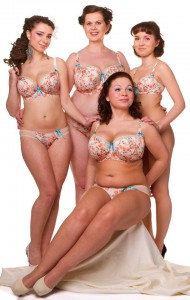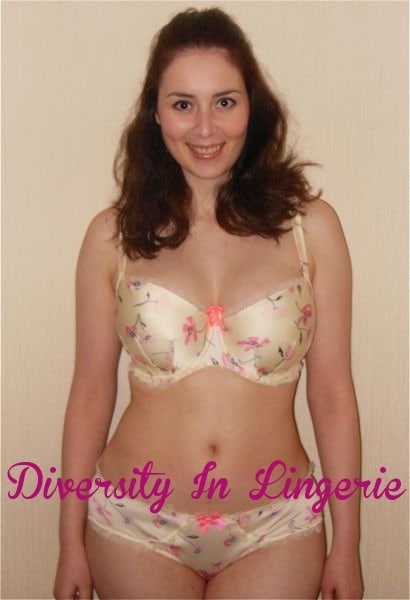Diversity In Lingerie: How Realistic Are Our Demands?
Diversity in the fashion world is getting there. In the last twenty years, we’ve seen fashion stores introduce collections, along side their mainstream lines, catering for the petite, tall, plus size and pregnant. Within the lingerie industry, in the last decade, the demand for D+ bras and bands below a 32 has seen the development of wider ranges and an influx of new large cup brands catering to the specific needs of the busty and slim. It seems body shapes of all dimensions are finally being identified and provided for. Women’s figures don’t fit a mould, one size does not fit all, women large and small equally deserve, and are entitled to, choice and freedom. So why are we not yet happy? What piece of the puzzle is the fashion industry missing? Are women still missing out?
Consumers these days have incredible power: we have voices and we have the modern age of technology where it only takes a single opinion to attract the attention of a worldwide audience. June of Braless in Brasil blog began a campaign recently called Diversity in Lingerie, to challenge the lingerie industry’s idea of body representation. Whilst different shapes and sizes are steadily being acknowledged with the manufacture of a wider choice, the representation of body diversity stops there. The production falls to a stark parallel with the advertising. The garments may be made available for the consumer to buy, but like a silent division, we don’t see it. In the same way a pregnant woman models maternity wear, if a 40G bra is produced, does it not make sense to see it modelled by a 40G wearer?
As a consumer most typically under represented I can see various points to the Diversity in Lingerie campaign; the small back/large cup bra wearer in me knows the frustration only too well. Looking at a bra modelled by a 32D woman means I can’t fully appreciate how it’ll look on myself (invariably it never looks as good in the larger cup size). If models showcasing garments for large boobs aren’t busty (or to a larger degree), it’s a lack of diversity that doesn’t serve the consumer. An inability to demonstrate a product on varying sizes and shapes is simply a manner of poor customer service, and what business what’s to attract that kind of attention?
Being a 30GG-28H, I value seeing a model wear my size. A small cupped version of a product can look massively different to a larger size. Not only does fabric equation differ, larger sizes are typically constructed in differing measures. It’s disappointing to me, as the consumer, to receive a bra with industrial straps when I made my purchase decision based upon a bra with dainty straps. This lack of diversity can be misleading. But that’s my point of view, as the consumer. As the brand, I may see this only one other way: as an expensive, unreasonable expectation. If a consumer wants to see different sizes and body shapes showcasing a product, how many models does one product require? In this respect, is this lack of diversity fair to the company? Are we realistic to expect dozens of images of one product on different models?
 |
| Ewa Michalak diverse models Image: Ewa Michalak |
As a freelancing model, I see the diverse range of looks that have to fight for work. Although many faces and body shapes deemed ‘irregular’ and even ‘ugly’ are in demand with work offers they can pick and choose from, the majority of models that don’t fit the mould demanded by the big guys in the fashion industry are swept aside. Being a size 12 would see me fall into the category of ‘plus size’ whose use is mediocre compared to that of the size 6 fashion model. Countless times I have applied for and missed out on work that was idealised for a figure unlike my own. When this figure represents the same old format, you feel pretty marginalised.
Whether our demands as consumers who want to see more diversity in fashion is feasible, I feel is debatable. In one sense, demonstrating a variation of skin colour helps serve a wider consumer audience which is good business sense. I’m for that. However, what if the designer thinks their garment is best showcased on a certain skin tone? A dark skin would show off a light colour well, as would a dark colour against fairer skin. If the brand chooses one over the other, are they being unfairly biased?
Photo manipulation is still a current interest regarding fashion and product imagery, and with good reason. Slimming down legs, eliminating natural forms of fat and smoothing skin is an unnatural representation. Changing a model to conform with a certain ideal of beauty is wrong because this isn’t body accepting. I wholeheartedly disagree with this.
But, would I want to see a model’s spots? No! What I see as a nuisance, simply an imperfection that I don’t recognise as a part of me is something I wouldn’t want to show off myself. I may not be bothered about a spot during my day to day life but if I were having a photo taken I’d want to look my best; my best being, when that spot has disappeared from my face! And, whilst I have cellulite and hate it, I do accept it’s normal, but even then I’m undecided as to whether I want to see it or not. A product image is exactly the same, to show it in it’s best light. A model not wearing make up does not work well with the camera, the use of make up coverage is a fact. If a model does not look her best, then that reflects poorly on the product. Where this may seem to be a lack of diversity in models who have spots/cellulite/scars, the fact stands that these ‘imperfections’ detract your focus away from the product.
 |
| A model seen at Milan Fashion Week with cellulite Image: Zimbio |
The progression of diversity in fashion is proving a fantastic sight. If you pick up a general magazine in the 21st century compared to some decades gone, you’re more likely to see women of colour, with shapely figures, petite heights and with looks that don’t resemble robotic mannequins. This doesn’t mean we are there yet. There are too frequent instances, in print and online, where models are being made to conform to standards that don’t represent the true diversity of women’s looks, and that’s what I feel still needs to be addressed. The slim with big boobs, the bottom heavy with small boobs, the apple shapes and the hour glasses. We’re all unique, we’re all real, and it’s high time we saw more diversity in lingerie.



Panty Buns
November 17, 2013 at 10:19 pmWhilst I agree that it may help create initial sales using models who appear healthy and blemish free, I think overall sales and improved lingerie design would result from using fuller figured models. I personally love full coverage briefs. The practice of using overly skinny models who have no discernible buttocks is not conducive to designing knickers having leg-bands that sit at the natural fold between the buttock and thigh, thus creating the more classic lingerie look and preventing ride-up. I’ve lost count of the number of times I’ve ordered briefs that appeared to provide coverage in photos of skinny models but turned out to be tailored in such a miserly fashion that I was loath to give them so much as a mention on my blog. I wonder how many returns are the result of not using more generously proportioned models thereby giving a more realistic idea of how the garment being modeled might will fit? With briefs it helps if the rise, side seam length and gusset measurements are given, but in many cases they are not.
With respect to bras, I understand there is a similar disconnect. It’s fortunate that with respect to bras some manufacturers are finally carrying bras designed for women with larger cup sizes but the lag in the use of models of some sizes is marked. I wear blouses in a U.S. size 18-20 (1X to 2X) but rarely get a good idea of how they will fit looking at the photos. The availability and selection of colours is often much smaller than it is for more “normal” sizes. I may prefer looking at models who have no cellulite, but I’d like an idea of how things might fit too.
I love the floral print satin panty and bra set you’re modeling in the first photo. You look fabulous! I also very much like the Ewa Michalak diverse models image.